|
Sigma Performance is founded on a belief that road racers, road riders and track enthusiasts have the right to enjoy the same levels of preparation that a race team would consider normal, but with a few twists to
suit their particular situation. In racing reliability matters, on the road it is essential. As well, some race mod's cost an awful lot for a minimal (but still important if you are on the track) return. Some
modifications however give quite a respectable improvement in overall engine and chassis performance for not so much…so how could we get all of the easy wins into a sensible package at a sensible price?
The Full Monty was born back in 1999 when we built an engine for our 748SPS that followed the 75:25 rule; we wanted 75 % of the benefits we reckoned we could get from a complete race build for 25% of the cost… That first Full Monty specification engine became the prototype for a whole range.
What we call the Full Monty preparation job is not a complete racing blueprint but it is 75% of the work of for 25% of the price. We give the bike the service of its life and while we are at it we concentrate on
getting all the power producing settings of the motor to within very very close tolerances to ensure the engine produces power in the way that Ducati originally intended, but which the time constraints of a mass
production line make difficult to achieve. The game is to make the standard components operate at their very best, usually enhancing reliability and longevity.
So what are the 'problems' that we think are worth sorting?
Well the first thing is to put them in their proper perspective, every bike made (everything made anywhere actually) has to be built within 'acceptable' tolerances; plus or minus a certain
measurement, unless we did this mass manufacture would be impossible to do…its just that on some very complicated machines it is quite expensive to get the tolerances at the best point without upping the original
price of manufacture to a ridiculous number..
Vee twins with 'mirror image' rear cylinders like the Ducati are particularly susceptible to this as every production mod made to get one cylinder right has the opposite effect on the
'other' cylinder; only assembling the bike as two 'connected single cylinders' with each cylinder done individually, and correctly, can smooth everything out and achieve the optimum performance. The same goes for
the suspension, setting the chassis accurately taking into account the type of engine (a good set-up for a 748 Bip is different to a good set-up for a 998RS!!), riders size, skill level and proposed use is an
individual thing and takes a bit of time and thought.
Ducati's age differently to other bikes too, with the Desmodromic valve system there are no heavy valve springs banging the valves shut against their seats, instead the various rockers and
levers get the valve very close to its seat and then the rising gas pressure as the piston comes up under the valve finishes the job of closing the valve. This means that the bike works a whole bunch better with
clean gas tight valve seats and it also works nicer if the clearances are accurate…the snags normally are that without a big spring closing the valve its is a lot easier for the seat to become dirty and leak.. Also
to try and reduce the costs of Ducati ownership the factory have expanded the range of acceptable valve clearances, now its not that these wider 'acceptable' clearances cause damage, its just that the bike runs a
lot better, smoother and more powerfully if the clearances are reset precisely to the original numbers at each service.
There are also a few classic Italian flaws that should be checked and sorted during a proper service, are the plugs that blank off the oil ways in the crank securely fixed? is the alternator
nut on tight? what do the rockers look like? and so on ... a lot of our work is a once only basis, but we specify a proper service structure for the future to ensure that those settings that do wear are properly
controlled.
So what we are actually doing with a Full Monty is servicing the bike and simultaneously building the bike accurately to standard specs, in a lot of cases there is nothing wrong with the
standard spec, its just that your nice new bike (or even more likely your nice but used bike!!) isn't accurately set at the standard spec.
But there are also some modifications that can be done at the same time that help some more……
For each bike in the Ducati range we try to have at least two alternative specs, revised specifications that add to the overall performance of each model, for some it is a bore job, 748's go
like rockets with 853 kits on them, for other's its revised non standard cam timing. We think the most important thing is easily accessible power with no surprises; so none of our mods make the bikes more peaky, we
concentrate on smooth power at all revs and throttle setting and chassis settings to complement this.
In addition to the above options, again depending on model, there are several things that can make big changes to the way the bike goes, a revised fuel map with an alternative map for the
rear cylinder, gives smoother midrange delivery. (Ducati fuel maps have always had the capacity to deliver different fuelling to the rear cylinder, but usually they don't bother). For some bikes a carefully
lightened flywheel is the answer, for track use there is the slipper clutch makes life much easier going into corners and so on.
So what do we do in a Full Monty?
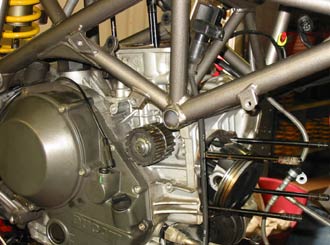
When a bike comes in the fairings come off and are put into careful storage at the top of the workshop and both the coolant and oil are drained. The radiator and fuel injection systems come off, as do
the exhausts, heads and barrels. Once the bike is stripped and the heads and barrels removed we carry out an inspection of the Rockers, cams, valves and their seats and have a look down into the
crankcase have to make sure that the crank shaft plugs are all intact and in the crank. Once we have reported back to the owner we are under way … the cylinder heads are stripped and the valves cleaned.
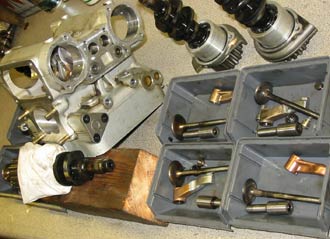
Then the valve seats and Valve faces are lapped to ensure a good gas tight seal, you might think this is a little excessive but you must
remember that on Ducati we don't have the big valve springs of a typical motorcycle engine and that the Desmodromic valve gear relies on the rising gas pressure in the cylinder itself to complete the valve
closing sequence, if the valve seat is damaged therefore is difficult to get full compression. There is no point in trying to do this without at least cleaning the valves as well so we do
that too, it has the happy side effect of making the gas flow work better. Once we have four valves correctly seated and opening and closing rockers in good condition we set
about shimming the head this we do to the original manufacturers tolerances, not the checking tolerances set out in the workshop manual as we believe that the correct original tolerances give
better and smoother low down running and more compression and more responsive motor elsewhere.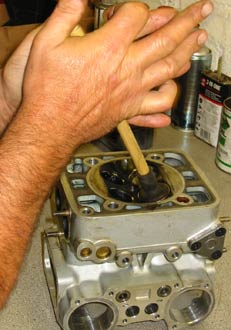
At the same time we clean the top of the Piston and check the condition of the piston rings and then we check the Squish. Squish is the distance between the
top of the piston and the cylinder head. A close squish clearance is designed to improve the engines ability to get a good burn from the fuel you have put in. If the piston to head clearance is just right it lets
the piston act on the mixture just like somebody slapping their foot in a puddle. There is a small flat area at the front and the back of the head and the gas that is trapped in that area is spat out into the
general combustion chamber, just like the water from that puddle, mixing up the rest of the mixture as it goes.
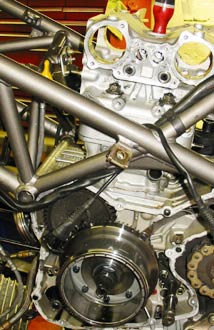
This ensures that when the spark is set off you get good and
complete combustion, and the best possible power for your buck, all this mean smoother running and more power but to get the really close tolerances where you get the best reaction, but
where you still don't actually touch the head with the Piston you need to do some pretty careful clearance checking by hand by hand and that's what we do.
While we are at it we check will the tightness of the Alternator Nut, and usually taking it off and re loctiting it to insure with that none of the bikes that have been Full
Montied suffer this classic Ducati problem, we also strip the clutch with and inspect the plates and to try to get the best clutch operation.
Having cams driven by Rubber Belts is not the most precise way of obtaining constant valve timing but accurate cam timing definitely helps the motor to run
well, it helps a harmonics in the airbox and it helps the harmonics in the Cylinders. If the front and rear cylinders are timed accurately it means the
engine is a much smoother piece. It's also possible on some models to set the cam timing to non standard settings and for several of the bikes we have a very good alternative setting to the
factory specified one that gives an alternative style of power delivery. 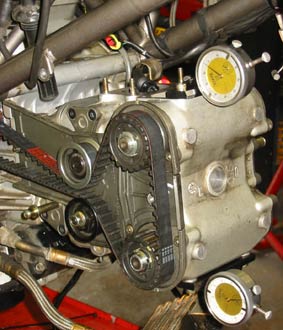 We want our bikes to be
robust in general service after we had done our work so rather than put adjustable cam pulleys on we use the old fashioned offset woodruff keys to ensure that once the cam timing is set it stays set and doesn't get
accidentally changed at a future service. We want our bikes to be
robust in general service after we had done our work so rather than put adjustable cam pulleys on we use the old fashioned offset woodruff keys to ensure that once the cam timing is set it stays set and doesn't get
accidentally changed at a future service.
When the engine is fully reassembled the ignition system goes back on, this has its throttle-position Sensor carefully re-set so that the zero position of the butterfly is
exactly where the computer thinks it is, given that the standard Ducati tolerance for this is plus or minus 10 per cent a plus or minus one per cent is a significant improvement. A new Eprom is loaded into a
computer giving a much greater variation to the fuel given to the rear cylinder, all Ducati's have had this capability since they went to fuel-injection but few have actually
used it. The Fuelling in the FIM Eproms we use, with matched and correct Squish on both cylinders and cam timing set accurately the fuel map is the icing on the cake for a
smooth-running engine. Fresh oil and filters complete the reassembly.
Once the airbox is reassembled (New Air filters too) on to the bike the fuel tank also goes back
on, but not until it has had a new Fuel Filter fitted. Then the Throttle bodies are balanced using a single vacuum gauge (its more accurate if both are set by the same gauge!!) once that is done
the idle set up is completed using the airscrews.
This leaves us with the chassis settings, the Forks are stripped, cleaned and rebuilt with a fresh oil
, we can do a standard fork rebuild or the valving can be slightly changed it for a more Track Day friendly setting with it. The rear suspension is also checked with the rear Ride Height being set to
a specification that we think is better than the one set by the factory, depending on the bike this is combined with moving the headstock to the vertical position to complement things.
Parts wise we will have used new Belts, base gaskets, head gaskets, half rings (they act like valve colletts), oil, all filters and exchange shims. We add a small sundries charge for all the little
gaskets and seals too. As we see things that are badly worn we replace them , typically one in five bikes will need new alternator wires for instance. Only after we get the owners permission
will we also replace damaged rockers and other larger parts.
So what can we add to a Full Monty to really transform the bike?
It's difficult in an article try to summarise all the bikes as each model has its own preferences; a brief summary of the options looks like this though. Have a look at our Technical pages for more
details on each bike.
So in addition to the normal servicing benefits of a Full Monty we can offer…..
On 748 Desmoquattro's we find they respond really well to 853 Kits as well as the Full Monty.
http://www.sigmaperformance.com/748-853.html
On the 748 SPS and the SP we can fit 853 kits or we can modify the cam timing for more midrange.
http://www.sigmaperformance.com/748spstech.htm#background
On the 748R we have several settings either standard Full Monty or with an 853 kit and a basic porting job or our latest 2004 set-up that uses a different porting and modified Throttle bodies to suit.
http://www.sigmaperformance.com/748r-853r.html
916's respond really well to the basic Full Monty and the FIM Eprom or we can open them up to 933cc.
http://www.sigmaperformance.com/916_senna.html
On the 996 Bip we have the basic standard setting but also have our Grunter cam timing version. This sacrifices a couple of top-end horsepower for a gain of around six or seven horsepower in
the midrange. Given that the Full Monty typically would find it six or seven more HP at the top end you don't really miss the couple that you don't get but you certainly notice the five to seven
in the midrange. A really nice extra for this is a lighter weight flywheel and lower gearing to turn this bike into a SPS killer.
http://www.sigmaperformance.com/ducati996bipracer.html
Our ST2's go like you wouldn't believe with a 966 kit, porting mods and a chassis set up.
On the Monsters and ST2's 4's and 4S's a Full Monty helps, and the chassis changes completely transform the bikes, the fuelling can be modified with (including the redline for those of you with
9500 rpm cutoffs on your S4's) Fim Ultimap computer. Again a lightweight flywheel makes a big difference. http://www.sigmaperformance.com/monstermash.html
http://www.sigmaperformance.com/st4.html
996 SPS and 996 S's can be built had either to standard Spec or with modified cam-timing for more midrange http://www.sigmaperformance.com/996sps.html#996SPS
The 998 S and the 999 S can be Full Montied or if you are really serious can be accurately built to our production racing spec. This is where the cam timing is reset to allow the bike to rev higher
and the combustion chambers and porting are modified to suit.
http://www.sigmaperformance.com/testastretta.html
And coming soon the 1080 Multistrada conversion……
Have a look at the relevant pages in tech for more details
Neil Spalding 2004
|